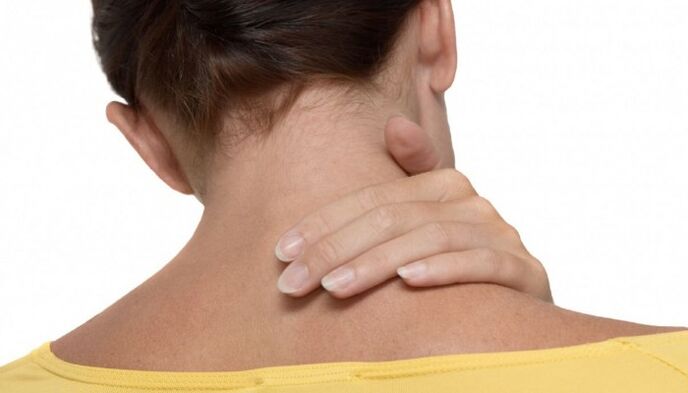Various back or neck pains can occur suddenly and always cause considerable discomfort. Particular vigilance should be caused by constant painful sensations of an intense nature. Neck pain and upper back pain can also be accompanied by other clinical symptoms, such as: B. Heaviness in the back of the head, tiredness, tiredness, headache, restricted mobility.
If the pain syndrome persists for more than a week and the treatment being carried out does not produce the desired results, professional medical help should be sought. Do not deprive yourself of the opportunity to get rid of the painful disease quickly and effectively.
The reasons

Many people wonder why the throat hurts. As practical experience shows, there can be many reasons for this. Clarification of such questions should be treated exclusively by a specialist, since the correctness of treatment directly depends on it. The most common reasons why the back and side of the neck can hurt very badly and frequently:
- Pathology of the cervical spine (various injuries, bruises, dislocations, intervertebral hernias, osteochondrosis, spondyloarthrosis, etc. ).
- Myogelosis of the neck.
- Great physical activity.
- Being in an uncomfortable position for a long time (e. g. sleeping while sitting).
- Sciatica of the cervix.
- Muscle stretching (sudden movement of the head, improper movement).
It has been found that even mundane scoliosis can cause pain.
Cervical spine pathology
If the patient complains that his neck and upper back are very painful and painful, the first thing to do is to exclude the pathology of the cervical spine.
Particular attention should be paid to osteochondrosis and spondylosis. Today, these are the two most common diseases of the spine, aside from injuries and injuries, which can cause significant pain and discomfort in the neck and upper shoulder girdle. Features of the pain syndrome in the degenerative-dystrophic pathology of the cervical spine:
- The pain is noticed at rest, even if the patient tries not to move at all.
- Usually it is quite difficult for them to choose a position in which they would not feel pronounced painful sensations.
- A limitation of mobility in the cervical spine is almost always noticed.
- Slight pressure on the cervical vertebrae can lead to increased pain.
Myogelosis of the cervical spine

A pathological condition in which there is painful compression of muscle fibers associated with a violation of local blood circulation is called myogelosis. As a rule, the provoking factors are:
- Hypothermia and freezing.
- Wind blows.
- Prolonged uncomfortable position.
- Physical fatigue (excessive stress).
Most experts believe that myogelosis should be viewed as a complication after an inflammatory process in the muscles. It should be noted that it manifests itself not only in pain, but also in problems with muscle relaxation, increased tone and reduced mobility. In addition, the pain often extends to the upper back and shoulder girdle. Leaving myogelosis without treatment risks worsening your health as the disease is prone to progression and chronicity.
If you do not know the real reason your neck hurts, it is better to consult a specialist doctor immediately.
Sciatica of the cervix

Pinching the nerve roots that emerge from the spinal cord at the level of the cervical spine leads to sciatica. According to clinical practice, in most cases, osteochondrosis is the cause of the development of this pathology. With sciatica, patients notice that the throat is sore and burning, making it simply impossible to touch it from behind or from the side. What is the clinical picture observed in case of damage to the roots of the cervical nerve emerging from the spinal cord:
- Strong and constant pain in the neck, shoulder blade, shoulder girdle.
- Sensations of pain usually increase with movements of the head, arms, and upper body.
- The neck muscles are too tense.
- There is a violation of sensitivity in the hands (numbness, tingling, etc. ).
- Weakness in the upper limbs.
- Dizziness.
- A headache.
- Increased tiredness.
Dislocate

Despite the severity of the pain syndrome, muscle strain is considered one of the mildest pathologies and is curable fairly quickly compared to other diseases that cause pain in the neck and upper back. Injuries, poor exercise performance, and increased stress can all lead to muscle stretching. What complaints will the patients express at the same time:
- Sharp pains in the neck, back of the head and upper shoulder girdle.
- Excessive muscle tension, which limits the mobility of the head and cervical spine.
- The general condition suffers (physical complaints, weakness, fatigue occur).
- The throat hurts when you turn your head.
diagnosis

Without finding out the specific cause of the appearance of pain in the cervical area, it is quite difficult to completely get rid of this pathological symptom. If we only eliminate painful sensations and not what is causing them, we can only expect temporary improvement in the condition. Modern diagnostic methods allow you to quickly narrow down the range of possible causes that are causing your neck to hurt from behind, from the side, or from both sides. As a rule, the following instrumental studies are used:
- Standard x-ray examination.
- Ultrasound examination.
- Electrocardiography.
- Electromyography.
- Magnetic resonance imaging.
treatment
What to do if your neck hurtsEven at home, you can take some remedial measures to relieve pain. If you associate pain with an injury or muscle strain, a cold compress is recommended for the first 48 hours.
A very effective remedy is to apply ice or cold objects to the neck area for about 15 minutes every few hours. In order to avoid a cold fire developing by touching the ice, direct contact with the skin must be excluded. To do this, ice or very chilled objects are placed in a plastic bag, additionally wrapped in a not too dense cloth and only then applied to the surface of the skin.
After two days they switch to warm compresses. You can use a regular plastic hot water bottle or a rubber heating pad. The duration of the application of the compress should not exceed 20-30 minutes. This process can be repeated every 2 hours. Also, give the sore muscles adequate rest. The first time you have an injury or sprain, go to bed more often and try to relax your neck muscles. It relieves tension best when you lie on your back. In the acute stage, it is useful to limit yourself to different types of physical activity. Take a short break from exercising.
Do not forget that a very long rest weakens the muscles of the neck and shoulder girdle. Once you get back to your normal rhythm, it will be easy to get a new stretch of already weakened muscles. A change from dosed physical activity and good rest is considered optimal, but only without severe pain. Traditional pain treatment is as follows:
- Drug therapy.
- Local treatment.
- Physiotherapy procedure.
- Manual therapy.
- massage
- Physical therapy.
Talk to your doctor about what to do if your neck is sore.
Drug therapy

Pain relievers help relieve neck pain of varying degrees of intensity quickly. Today, many of these drugs can be bought from pharmacies without a prescription from your doctor. However, it should be noted that most of these drugs have a significant number of side effects and contraindications. Therefore, every medication intake must be coordinated with a specialist. Most often, nonsteroidal anti-inflammatory drugs are used as pain relievers.
Numerous clinical studies have shown that taking NSAIDs can cause a number of side effects. Most of the problems are associated with erosive and ulcerative lesions of the gastrointestinal tract. In addition, in addition to the pain syndrome, there is often pronounced tension in the neck muscles. To relieve muscle spasms, it is recommended to use muscle relaxants.
Local therapy

Topical therapy has been shown to be beneficial in controlling neck and upper back pain. As a rule, all kinds of medicinal ointments, gels and creams that have a pronounced analgesic effect are used. Certain types of drugs are very popular as external agents.
The mechanism of the analgesic effect is different and depends on the active ingredient that is part of the ointment, gel or cream. Only a qualified doctor can tell you which medication is best for your case. Novocaine blockade is sometimes prescribed for severe pain that causes significant discomfort. Medical compresses have also been shown to be effective. The average duration of the procedure is around 30 minutes. To achieve the desired result, a total of at least 7-8 procedures must be performed.
If you are not entirely sure what to do when your neck and upper back hurt, it is best to consult a specialist first.
physical therapy

In most cases, physiotherapy treatment is actively involved and consists of various procedures, massages and physical therapy exercises. Years of experience have shown the effectiveness of the following physiotherapeutic methods for pain relief:
- Electrophoresis.
- Ultrasound therapy.
- Electrotherapy.
- Magnet.
- Laser.
- Acupuncture.
Exercise therapy and massage
Therapeutic exercises and massages are mandatory components of complex therapy for almost any disease or pathological condition. However, many people forget that they can only be used when the acute stage is over. Severe pain syndrome is considered a contraindication to exercise therapy and massage. An example of a series of basic physical exercises designed to relax and strengthen the neck muscles:
- You can stand or sit. The main thing is to keep your back straight. The hands should be relaxed and down. Perform 10 head tilts, first to one side, then to the other. Do the exercise at a calm pace without sudden movements.
- The situation is similar. We tilt our head down and try to touch the front of the chest with our chin. The number of repetitions is 10 times.
- The situation is similar. We move our heads back and forth and imitate a duck. The number of repetitions is 10 times in each direction.
- Slow circular movement of the head. When painful sensations appear, we stop doing the exercise.
- We sit on a chair. Place the palm of your hand on your forehead. We tilt our head forward and try to resist with the palm of our hand. Exercise helps strengthen the front neck muscles. You can also place your palm on the left, right, and back and tilt your head to the appropriate side.
- Stand up straight. Relax your arms and place them along your body. We tilt our head to one side first while lifting our shoulder, then to the other. The number of repetitions is 10-12 times.
After a short briefing by a physiotherapist or another specialist, therapeutic exercises and self-massages of the collar zone can be carried out regularly and easily at home.
Ethnosciences

It's hard to argue that traditional medicine has long been entrenched in our lives. However, if you are unsure of where a particular folk remedy came from, it is not recommended to use it for treatment. Many doctors have seen serious consequences of abuse of non-traditional treatments more than once in their clinical practice. In some cases, it is allowed to use certain folk remedies to get rid of pain, but only after consulting a doctor. Exclusively for acquaintance, we present various traditional medicine recipes:
- You can apply a regular fresh cabbage leaf to the painful area. There are no deadlines. Compresses made from cabbage leaves also have a good effect.
- Rub honey. Massaging honey is rubbed in the place on the neck where the patient is in the greatest pain.
- Mustard and salt compress. For cooking you need a kilogram of table salt, a spoon of mustard powder and 100 ml of water. Put all ingredients in the pan and heat for 5 minutes. Then the mixture is poured into a handkerchief pouch, which we put on the painful neck area. To increase the effect, you can wrap a warm cloth around your neck (e. g. a scarf).
prophylaxis

In many cases, it can prevent quite uncomfortable pain in the neck from occurring. To do this, it is necessary to avoid various types of injuries, muscle tension, and heavy physical exertion. It is highly undesirable to freeze or overcool. It is also recommended that you exercise actively, but not to the detriment of your health. Do not start with chronic diseases, especially degenerative-dystrophic pathologies of the musculoskeletal system. Get a thorough medical examination at least once a year.


































